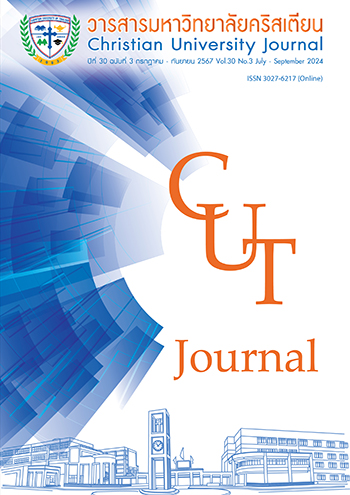ปฏิกิริยาลูกโซ่ด้านความแข็งแรงของกล้ามเนื้อรยางค์ส่วนล่าง ในนักกีฬาข้อเท้าไม่มั่นคงเรื้อรัง
คำสำคัญ:
ข้อเท้าไม่มั่นคงเรื้อรัง, ปฏิกิริยาลูกโซ่, ความแข็งแรงของกล้ามเนื้อบทคัดย่อ
การวิจัยครั้งนี้มีวัตถุประสงค์เพื่อศึกษาความสัมพันธ์ของปฏิกิริยาลูกโซ่ที่เกี่ยวข้องกับความแข็งแรงของกล้ามเนื้อรยางค์ส่วนล่างในนักกีฬาข้อเท้าไม่มั่นคงเรื้อรัง และเปรียบเทียบความแตกต่างของความแข็งแรงของกล้ามเนื้อระหว่างนักกีฬาข้อเท้าไม่มั่นคงเรื้อรัง กับนักกีฬาข้อเท้าปกติ ในกลุ่มตัวอย่างนักกีฬาฟุตบอลชาย อายุ 19-25 ปี จำนวน 46 คน ที่ถูกคัดเลือกแบบเฉพาะเจาะจง แบ่งออกเป็น 2 กลุ่ม ได้แก่ นักกีฬาข้อเท้าไม่มั่นคงเรื้อรัง และนักกีฬาข้อเท้าปกติ กลุ่มละ 23 คน ทดสอบความแข็งแรงของกล้ามเนื้อรยางค์ส่วนล่าง ประกอบด้วย ข้อเท้า ข้อเข่า และข้อสะโพก ด้วยเครื่องไอโซคิเนติก ขณะกล้ามเนื้อหดสั้นเข้า ด้วยความเร็วคงที่ 60 องศาต่อวินาที วิเคราะห์ข้อมูลโดยใช้สถิติเชิงพรรณนา การทดสอบค่าที วิเคราะห์ความสัมพันธ์ด้วยสถิติสหสัมพันธ์แบบเพียร์สัน รวมทั้งสถิติแมนน์-วิทนีย์ที่ใช้กับตัวแปรที่แจกแจงแบบโค้งไม่ปกติ และกำหนดความมีนัยสำคัญทางสถิติที่ .05
ผลการวิจัยพบว่า นักกีฬาข้อเท้าไม่มั่นคงเรื้อรังมีความแข็งแรงของกล้ามเนื้อหมุนสะโพกเข้าแตกต่างกับนักกีฬาข้อเท้าปกติอย่างมีนัยสำคัญทางสถิติที่ระดับ .05 (p = .04) ในส่วนความสัมพันธ์ของนักกีฬาข้อเท้าไม่มั่นคงเรื้อรัง ไม่พบความสัมพันธ์ระหว่างความแข็งแรงของกล้ามเนื้อรอบข้อเท้า กับความแข็งแรงของกล้ามเนื้อรอบข้อเข่าและข้อสะโพกอย่างมีนัยสำคัญทางสถิติ (p > .05) งานวิจัยชี้ให้เห็นว่า การเสริมสร้างความแข็งแรงของกล้ามเนื้อหมุนเข้าของข้อสะโพกในนักกีฬาข้อเท้าไม่มั่นคงเรื้อรัง ยังคงต้องให้ความสำคัญอย่างต่อเนื่องควบคู่กับโปรแกรมการฝึกซ้อมหรือการฟื้นฟู รวมทั้งควรศึกษาถึงปัจจัยอื่น ๆ ที่เชื่อมโยงสัมพันธ์กันตามแนวคิดปฏิกิริยาลูกโซ่เพิ่มเติม
เอกสารอ้างอิง
ณภัทร เครือทิวา และวิไล อโนมะศิริ. (2557). การทดสอบประสิทธิภาพการทำงานของข้อเท้าเพื่อใช้ในการวินิจฉัยภาวะความไม่มั่นคงของข้อเท้าเรื้อรัง. การประชุมวิชาการเสนอผลงานวิจัยระดับบัณฑิตศึกษา ครั้งที่ 15 (น. 1171-1176). ขอนแก่น: มหาวิทยาลัยขอนแก่น.
Arunakul, M., Arunakul, P., Suesiritumrong, C., Angthong, C., & Chernchujit, B. (2015). Validity and reliability of Thai version of the foot and ankle ability measure (FAAM) subjective form. J Med Assoc Thai, 98(6), 561-567.
Attenborough, A.S., Hiller, C.E., Smith, R.M., Stuelcken, M., Greene, A., & Sinclair, P.J. (2014). Chronic ankle instability in sporting populations. Sports Med, 44(11), 1545-1556.
Bettin, C.C., Richardson, D.R., & Donley, B.G. (2015). Ligamentous injuries of the ankle: Sprained ankle. In M. N. Doral & J. Karlsson (Eds.), Sports injuries: Prevention, Diagnosis, Treatment and rehabilitation (pp. 1753-1761). Berlin, Heidelberg: Springer Berlin Heidelberg.
Camacho, L.D., Roward, Z.T., Deng, Y., & Latt, L.D. (2019). Surgical management of lateral ankle instability in athletes. J Athl Train, 54(6), 639-649.
Cho, B.K., Park, J.K., Choi, S.M., Kang, S.W., & SooHoo, N.F. (2019). The peroneal strength deficits in patients with chronic ankle instability compared to ankle sprain copers and normal individuals. Foot Ankle Surg, 25(2), 231-236.
D’Hooghe, P., & Karlsson, J. (2015). Chronic ligament injuries of the ankle joint. In M. N. Doral & J. Karlsson (Eds.), Sports injuries: Prevention, Diagnosis, Treatment and rehabilitation (pp. 1711-1725). Berlin, Heidelberg: Springer Berlin Heidelberg.
Dejong, A.F., Koldenhoven, R.M., & Hertel, J. (2020). Proximal adaptations in chronic ankle instability: Systematic review and meta-analysis. Med Sci Sports Exerc, 52(7), 1563-1575.
Hall, E.A., Chomistek, A.K., Kingma, J.J., & Docherty, C.L. (2018). Balance- and strength-training protocols to improve chronic ankle instability deficits, Part I: Assessing clinical outcome measures. J Athl Train, 53(6), 568-577.
Hertel, J., & Corbett, R.O. (2019). An updated model of chronic ankle instability. J Athl Train, 54(6), 572-588.
Janicijevic, D., Knezevic, O. M., Garcia-Ramos, A., Cvetic, D., & Mirkov, D. M. (2020). Isokinetic testing: Sensitivity of the force-velocity relationship assessed through the two-point method to discriminate between muscle groups and participants' physical activity levels. Int J Environ Res Public Health, 17(22), 8570.
Khalaj, N., Vincenzino, B., & Smith, M.D. (2021). Hip and knee muscle torque and its relationship with dynamic balance in chronic ankle instability, copers and controls. J Sci Med Sport, 24(7), 647-652.
Kobayashi, T., Koshino, Y., & Miki, T. (2021). Abnormalities of foot and ankle alignment in individuals with chronic ankle instability: A systematic review. BMC Musculoskelet Disord, 22(1), 683.
Kosik, K.B., Johnson, N.F., Terada, M., Thomas, A.C., Mattacola, C.G., & Gribble, P.A. (2020). Decreased ankle and hip isometric peak torque in young and middle-aged adults with chronic ankle instability. Phys Ther Sport, 43, 127-133.
McCann, R.S., Crossett, I.D., Terada, M., Kosik, K.B., Bolding, B.A., & Gribble, P.A. (2017). Hip strength and star excursion balance test deficits of patients with chronic ankle instability. J Sci Med Sport, 20(11), 992-996.
Myers, T.W. (2020). Anatomy trains: Myofascial meridians for manual therapists and movement professionals. (4th ed.). China: Elsevier health sciences.
Page, P., Frank, C.C., & Lardner, R. (2010). Assessment and treatment of muscle imbalance: The Janda approach. USA: Human Kinetics.
Steinberg, N., Dar, G., Dunlop, M., & Gaida, J.E. (2017). The relationship of hip muscle performance to leg, ankle and foot injuries: A systematic review. Phys Sports Med, 45(1), 49-63.
Suchomel, T.J., Nimphius, S., & Stone, M.H. (2016). The importance of muscular strength in athletic performance. Sports Med, 46(10), 1419-1449.
Utsahachant, N., Sakulsriprasert, P., & Vongsirinavarat, M. (2012). Comparisons of foot posture and ankle and knee strength between athletes with and without chronic ankle instability. J Sports Sci Technol, 12(2), 107-116.
Ward, S., Pearce, A.J., Pietrosimone, B., Bennell, K., Clark, R., & Bryant, A.L. (2015). Neuromuscular deficits after peripheral joint injury: A neurophysiological hypothesis. Muscle Nerve, 51(3), 327-332.
ดาวน์โหลด
เผยแพร่แล้ว
ฉบับ
ประเภทบทความ
สัญญาอนุญาต
ลิขสิทธิ์ (c) 2024 มหาวิทยาลัยคริสเตียน

อนุญาตภายใต้เงื่อนไข Creative Commons Attribution-NonCommercial-NoDerivatives 4.0 International License.



